Social Media: The Most Economical Yet effective Marketing Tool
Tags: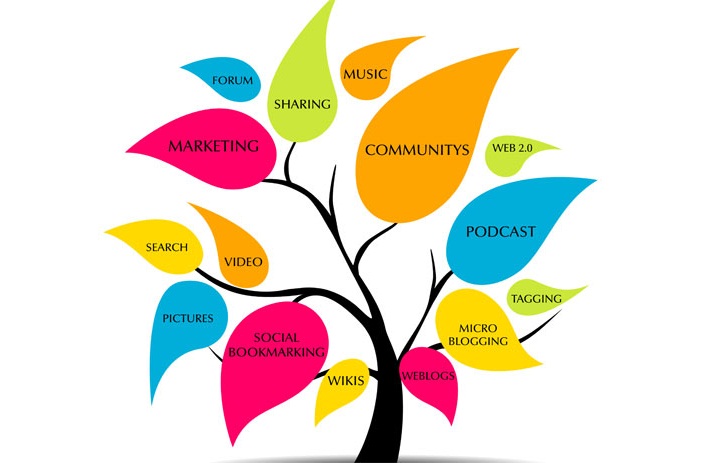 We all know that social media is huge today. People just can’t live without sharing what they feel or displaying what they wear. It’s all sociology from one perspective but it can also mean marketing to a few from another perspective. It is a common fact that where there is sugar there will be the bees. Similarly whenever there are huge concentrations of people, the marketer and advertisers are always there to make use of such situations and struggling to sell products or gain a good brand reputation.
We all know that social media is huge today. People just can’t live without sharing what they feel or displaying what they wear. It’s all sociology from one perspective but it can also mean marketing to a few from another perspective. It is a common fact that where there is sugar there will be the bees. Similarly whenever there are huge concentrations of people, the marketer and advertisers are always there to make use of such situations and struggling to sell products or gain a good brand reputation.Customer retention is by far the most effective way through which a business may gain prosperity and customer retention could only be possible when the people are repeatedly reminded of a brand or a shop or by simply infusing in them a desire to feel the need of anything which the company might be selling. With the advent of social media or to be more precise, when the social networking became the life of the people around the globe, viewership at a specific portal started increasing. Since all that a good TV channel needs is ratings to attract advertisers, here at social networking websites all was already set. People are frequently logging in and out of websites like Facebook, uploading pictures to get comments and statuses to tell their friends what they are going through.
The high concentration of people gathering around the social networking websites provides the traders with the cheapest form of marketing possible. The best part is that the add is displayed on various places and even if the user ignores the advertisement the people around the user may notice the availability of a new item at a some celebrated store and might hasten to buy it before someone else from the community buys. The desire to stand unique among the rest is experienced by everyone and it is this very desire which the traders may cash even when they are trading for wholesale products.
It is an open secret that nearly everyone uses Facebook, Twitter, LinkedIn, Instagram etc. these days. People even prefer to buy cell phones supporting applications which may lead them straight and in as less time as possible to their cyber wall where they post all their statuses or tweets or whatever they want to post. So naturally potential customers are always there looking for ways and means to get a better bargain in the market, searching for some better way to defeat that big competitor who usually gets all the customers due to his high quality yet economical products. Here is where the wholesale traders can actually seal a good deal and earn major profits if only they can post their advertisement, which is always facilitated by such websites.
Social media has by far, revolutionized marketing in every way imaginable. Advertising in now cheaper, effective and result oriented and many businesses are gaining the upper hand in the markets just by a little but careful investment on the social media. What people need to do is to concentrate on social media for advertising their products as compared to getting involved in other expensive, less effective means of advertising.
Written by Robert.
DealerNet Services
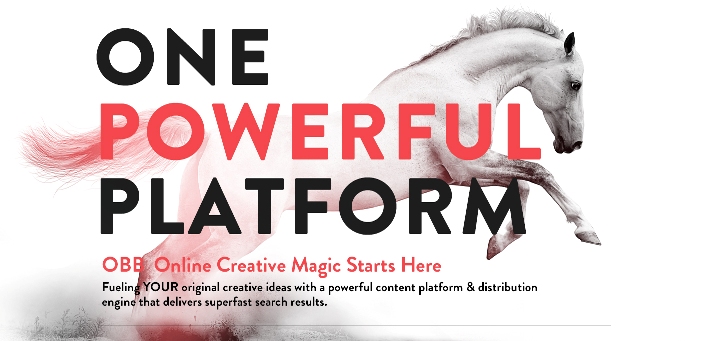
Innovation is the key to change. The creative spark to constantly make things better is what fuels our imaginations. We are constantly inventing new product features. From a gallery application that morphs into a screen wide display map to mobile applications involving images – we come up with innovations and news features to the OneBigBroadcast platform almost daily.
Our creative team is always pushing the envelope of the newest browser features that result in stronger branding and better user experiences. While the creative team is conceptualizing our platform team works hand and hand constantly inventing new ways of displaying important content or coming distributing it far and wide for maximum social value.
Change happens so much here at OneBigBroadcast that we often don’t take any notice of it. In fact we come up with major changes and innovations almost every week.
Those same changes and innovations then become part of the overall platform as upgrades and the entire user base benefits from the innovative spirit alive here OneBigBroadcast.
One thing is for certain - we've got some great new features and applications just about to be released that will help take your business to the next level!
To get a glimpse into innovation at work check our how our blog engines work and how one post touches between 100 and 345 social touch points all connecting back to enhance your oveall brand's visibility. That's why change is good
See blog Data Touch Points Here
 Words are hooks, words are levers There's a debate raging in my town over whether or not to replace the existing planted-grass school football field with what used to be known as Astroturf. One side has already won a crucial victory: the local paper calls the new alternative, "turf."
Words are hooks, words are levers There's a debate raging in my town over whether or not to replace the existing planted-grass school football field with what used to be known as Astroturf. One side has already won a crucial victory: the local paper calls the new alternative, "turf."Turf is what we call a racetrack, or half a fancy dinner (surf and...). Turf is short and punchy and feels organic. If they had called it 'plastic' or 'fake grass' or 'artificial turf', every conversation would feel different before we even started.
What to call the new diamonds that are being manufactured in labs, not dug out of the ground under horrible conditions? Some want them to be called 'artificial diamonds' or not diamonds at all. Others might prefer 'flawless' diamonds (because they are) or 'perfect'.
Is it a 'course', a 'group' or a 'club'? It might be all three, but the word you choose will change the anchor and thus the leverage that word has going forward. Are you a 'consultant', an 'advisor' or a 'coach'?
Engineers and doctors and other scientists seem to think they're skipping all of this when they use precise, specific language. But the obvious specificity and the desire to scare off untrained laypeople is in itself a form of leverage.
For politicians and others that want to re-invent the language for their own ends--you can work to plant your hook anywhere you choose, but if you torture the meaning and spin, spin, spin, you risk being seen as a manipulator, and all your leverage disappears. If your hook finds no purchase, you have no leverage.
On the other hand, the great brands (Pepsi, Kodak, etc.) planted words that meant nothing and built expensive fortresses around their words, words that now have emotional power.
The only reason words have meaning is because we agree on what they mean. And that meaning comes from associating those words with other words, words that often have emotional anchors for us. This isn't merely the spin of political consultants. It goes right to the heart of how we (and our ideas) are judged.
Written By Seth Godin
DealerNet Services
The Often Forgotten Ingredient For Measuring Content Marketing
Tags:
 Content marketing is now a way of life for B2B businesses. It’s one of the primary ways B2B marketers generate and nurture leads, establish thought leadership, build their brands, expand their social following, and engage with and retain customers.
Content marketing is now a way of life for B2B businesses. It’s one of the primary ways B2B marketers generate and nurture leads, establish thought leadership, build their brands, expand their social following, and engage with and retain customers.
If you’re a B2B marketer, this probably isn’t news. We’ve been reading and hearing about the importance of content marketing for years. But it was still good to see the importance of content marketing confirmed in a recent 2013 study by the Content Marketing Institute, which found that 33% of B2B marketing budgets are now allocated to content marketing, which is up from 26% in 2011.
Content marketing has certainly arrived. But with increased budget comes increased scrutiny from executives and higher-ups. And getting management to buy in to the importance of content marketing – and the necessity of increasing their investment in it – can be a challenge. It’s now no longer good enough to create engaging content, you have to be able to prove its ROI, and that requires the right data and tools.
Proving content marketing needs data
Good marketing teams are able to show how their content is having a positive impact on the following.
- Web traffic
- SEO
- Social media followers
- Newsletter email lists
- Blog subscribers
- Email open and click-through rates
- Video views
Measuring that data is a good start, but while those numbers are useful in understanding the types of content and topics your audience enjoys, they aren’t going to impress most executives.
Better marketing teams can show how their content is having a direct impact on lead generation. Being able to demonstrate that this eBook or webinar generated X amount of leads usually gets an exec’s attention, but this usually isn’t enough to convince them that your content marketing budget is worth increasing (or, in some cases, justifiable as it already is).
Show me the money
That’s why the best marketing teams are the ones that can prove how those leads from content marketing are impacting revenue. For CEOs, revenue is everything.
They need to see the money.
It’s the key figure that will get them not only to buy in to the value of content marketing, but also to approve an increase in your budget.
Three essential analytics tools
Being able to prove how content marketing is impacting revenue requires three analytics tools. The first two are a marketing automation tool and a CRM system.
1. Marketing automation
Marketing automation tools like Marketo, Eloqua, or Pardot enable you to capture leads from web forms and to tie those leads to the marketing source that referred them. This means that you can create reports on how many leads each of your eBooks, white papers, webinars, and other content generated, as well as the email, web page, social media post, blog, video, PPC ad, SEO term, or other source the lead used to find you.
2. CRM systems
What’s more, when you integrate your marketing automation tools with a CRM system like Salesforce.com or SugarCRM, you can track each of those web leads through the sales cycle. And that means being able to prove to execs that your content marketing has generated X amount of web leads, Y amount of opportunities, and Z amount of revenue.
So what tool is often missing?
The often forgotten analytics tool
The data available from a marketing automation tool integrated with a CRM system can be very powerful, but if that’s all you are using to defend your content marketing, you aren’t doing it justice.
That’s because all you are measuring are the opportunities and revenue from web leads. You aren’t capturing the inbound phone calls your content is also generating, and this is problematic for two big reasons:
- You might not be getting credit for a ton of content marketing leads. If someone reads a blog and calls sales, for example, or calls after watching a video, reading collateral from a trade show, or getting a nurturing email, you can’t prove it.
- Inbound phone calls are often from leads who are ready to engage with a sales manager, and therefore more likely to become revenue than a web lead. Phone calls are the leads you most need to track back to your content.
That’s why the third analytics tool every B2B marketing team should use is a call tracking tool. Call tracking tools enable you to include unique trackable phone numbers in your downloadable and printed content, videos, trade show presentations, emails, ads, and direct mail blasts to measure the calls they generate. Even if a lead visits your web site before calling you, call tracking tools can still tell you how that caller found your site and the web page or blog posts they called from.
Integration is key
And like marketing automation tools, you can integrate call tracking tools with your CRM system to follow each phone lead through to revenue. By using all three analytics tools together, you can share detailed, accurate reports on the impact your content is having on the business’s bottom line. It’s an extremely compelling defense of content marketing that CEOs can understand. Plus you have the more granular data marketing teams can use to understand what content is working and what isn’t in order to make improvements.
Guest Author: Blair Symes from Ifbyphone. To learn more about call tracking and improving your content marketing ROI, you can download the white paper, “Tracking Phone Leads: The Missing Piece of Marketing Automation.â€
Â
Learn how to  create contagious content
My book – “Blogging the Smart Way – How to Create and Market a Killer Blog with Social Mediaâ€Â shows you how.
It is now available to download. I show you how to create and build a blog that rocks and grow tribes, fans and followers on social networks such as Twitter and Facebook. It also includes dozens of tips to create contagious content that begs to be shared and tempts people to link to your website and blog.
I also reveal the tactics I used to grow my Twitter followers to over 170,000.
Read more about it here where you can download and read it .
Written by Blair Symes
DealerNet Services
Why Your Company's Customer Experience May Be Falling Behind
Tags: Regular readers of the Help Scout blog know that we love research and statistics.
Regular readers of the Help Scout blog know that we love research and statistics.I recently came across new consumer data from Forrester, a global research and advisory firm specializing in the customer experience, which features a number of shocking claims.

While many companies think that they are leading the charge with service quality and creating an innovative customer experience, the numbers tell quite a different story … in the eyes of customers, most companies are falling flat.

Today we are going to scrutinize what most companies are doing incorrectly and highlight how to fix these problems.
Avoid reading at your own risk, since we’ll be putting the spotlight on why less than 10 percent of companies are receiving a passing grade from customers!

1. Too Much Imitation, Not Enough Innovation When it comes to delivering an outstanding customer experience, far too many companies are content with simply “keeping up with the Joneses.â€
In the most recent Forrester survey of 100 customer experience professionals, 58 percent of respondents said that their firms drive customer experience innovation by closely watching what their direct competitors are doing, and a full 72 percent look to outright copy companies in other industries.

The embarrassing amount of copying that is going on has been recently pointed out by research analyst Kerry Bodine, and it’s the reason why “good enough†is the disappointingly low bar to which many companies now strive:
Citibank wanted to copy the Apple store so badly that it actually hired the same architects responsible for the Apple store concept to design its bank of the future. Imitation may be the highest form of flattery—but it's not innovation.†There is a lot more risk in copying your competitors than you may think. First of all, they might not know exactly what they are doing; even if they do, it doesn’t mean that what works for them will work for you.

Even worse, many companies are not seeking to imitate the industry leaders, or those businesses most known for their customer experience. According to the Forrester analysis published in the Harvard Business Review:

…13% of companies said that they'll settle for nothing less than having the best customer experience across every industry—in other words, these companies want to be the next Apple, Disney, or Zappos.â€Ã¢Ã‚۬ That leaves a whopping 87 percent of companies who will settle for less than the best when it comes to their customer experience!
We’ve previously shown you the data on how 80 percent of companies believe they are delivering superior service to their competitors. In light of these admissions, it’s easy to see why in reality they are falling flat. Consider this startling statistic from the Forrester survey:

In 2013, only 8% of the companies surveyed received a top grade from their customers for their customer experience.
The problem: Many companies think that they are leading the charge in customer experience innovation, but in reality they are okay with being just “okay.â€Ã¢Ã‚۬
This sort of thinking is dangerous. You’ll never be able to convince customers to switch to your company by simply matching the passable service quality of your competitors.
The image below offers a supporting example (because here at Help Scout, we’re nothing if not honest!) of this fact. Many of our prospective customers who are currently with a competitor stay not because they are blown away by what they are paying for, but because their current experience is “good enough.â€Ã¢Ã‚۬
Since the majority of companies are failing to deliver when it comes to customer expectations, following their lead will likely result in a vicious cycle of the blind leading the blind. Being at the head of the pack means turning your back to them.

2. Using Technology as a Crutch A great customer experience is still reliant on memorable employee-to-customer interactions. In other words, it’s still about the people. (Breaking news: The sun is hot!)

Why, then, do so many companies rely on technology as the crutch for delivering their service?

Keep in mind that technology alone isn’t the culprit here; the issue is using technology without considering the needs of your customers (“technology for technology’s sakeâ€), which can end in disaster.
A multinational auto insurance company provides an excellent example here. The company invested heavily in a new mobile app that would connect customers to a call center agent in an emergency.
The idea looked good on paper, but it failed to account for the fact that drivers wouldn’t preemptively download the app in anticipation of getting into a car crash … and they had more pressing things on their minds than browsing an app store once an accident occurred.
The result: Another so-called innovation that failed to produce business results.

The lesson here is that new ways to improve the customer experience must be founded in differentiation and their ability to generate long-term value for the business.
Simply being innovative or on-trend won’t result in real improvements in doing business with your company.
Remember why this app fell flat, and be sure that the improvements you make are geared toward resolving the issues that actually plague your customers.
How to Fix These Problems Bodine has outlined a few smart, applicable strategies for putting some of the worries discussed above to bed.

Below are her top three tips for avoiding a stagnant, misguided customer experience.

Tip #1 Rethink Opportunities Before Moving Academic research has shown that when it comes to brainstorming, the best ideas and most creative solutions result from looking at the problem from multiple angles. As Einstein said, “If I had an hour to solve a problem, I’d spend 55 minutes thinking about the problem and five minutes thinking about solutions.â€
Bodine sees the lack of multi-angled investigation as one of the fundamental errors that most business owners make when they seek to improve the customer experience. She highlights this point in her HBR piece:
Companies need to start their innovation initiatives with an outside-in approach that frames their business challenges within the context of customers' unmet needs.†Essentially, Bodine is saying that companies should reframe and closely evaluate what customers actually want before diving headfirst into the latest favored strategy in the world of CRM. This advice seems obvious, but as evidenced in the insurance example above, companies are prone to creating apps and new tools without closely evaluating whether or not they will truly be useful to customers or whether they solve a real pain point.

Bodine continues with an example from Philips Healthcare, who gathered customer feedback by using an innovative real-life form of user testing:

To identify new opportunities, for example, Philips Healthcare mapped out a typical day in the life of a radiologist, a key purchase influencer, regardless of whether those activities involved Philips. This approach enabled the team to identify a key pain point in radiologists' daily work—an inability to compare one patient's scan with those of others—that Philips already had the data for and capability to solve but hadn't considered productizing.â€Ã¢Ã‚۬ Tip #2 Infuse the Experience with the Brand Many of the most memorable customer experience innovations are strongly tied to the brand that first championed them. In many instances, the idea wasn’t so much unique as it was different. Bodine points to some big brands that were able to pull this off:

Ikea Systems' cartoon furniture assembly instructions, Mini Cooper's retro-inspired dashboard, and the cheerful chirp of a Zappos’ customer service rep—the qualities of these customer experiences create strong associations with their brands.â€Ã¢Ã‚۬
When your customer experience is intrinsically tied to your brand, you will naturally avoid the first problem discussed above—innovations, features and experience improvements that don’t suit your customers’ actual needs.

In another fascinating case study, Bodine highlights how a new restaurant concept from Bertucci’s addressed this highly important aspect:
That's why design and innovation consultancy Continuum created mood boards when developing a new restaurant concept for Bertucci's called 2ovens. A collage of carefully chosen photos depicted the desired 2ovens vibe; helped align internal Bertucci's stakeholders; guided the design of touchpoints as diverse as the dining space, menu, and website; and even shaped the company's hiring policies.â€Ã¢Ã‚۬ A 2ovens-style focus on innovation efforts that fit your brand’s personality and way of doing business will also help you create experience-specific elements that your competitors can’t easily mimic.
Tip #3 Create an Experience Around the Business Model Lastly, Bodine encourages companies to innovate in areas that best support their business model of choice. Just as choosing the right channel for customer service is critical (whether you adhere to traditional or newer online service methods), innovations for the customer experience should be based on the business you are running and your business model’s inherent strengths.
As an example, Bodine focuses on how ZipCar was able to spur on innovation where other traditional companies couldn’t compete:

Zipcar's car-sharing business model drove a need for keycard (and then mobile phone) vehicle entry—new types of interactions that traditional rental companies never envisioned.†Where can your company improve the customer experience and overall satisfaction while playing off of the advantages of your industry and how you do business?

 This is an interview I did with Klout for their Klout Stars series, where they ask “influencers†about their background in social media. 1. How did you get started in social media? I was originally a political consultant, helping manage campaigns for Governor, U.S. Senate, and President. I moved out of that industry into digital marketing in 1994. Since then, I’ve owned several companies in the online marketing world, including an award-winning agency that I sold in 2005. In 2008, I started Convince & Convert to help corporations and other agencies strip away the hype and successfully integrate social media.
This is an interview I did with Klout for their Klout Stars series, where they ask “influencers†about their background in social media. 1. How did you get started in social media? I was originally a political consultant, helping manage campaigns for Governor, U.S. Senate, and President. I moved out of that industry into digital marketing in 1994. Since then, I’ve owned several companies in the online marketing world, including an award-winning agency that I sold in 2005. In 2008, I started Convince & Convert to help corporations and other agencies strip away the hype and successfully integrate social media.
I love social because it’s the perfect combination of online marketing and retail politics. You’re trying to win hearts and minds one at a time, or a few at a time using stories and humanization, but you’re using digital techniques to do so, rather than salacious 30-second ads and cheesy direct mail.
I started my Convince & Convert blog to create a place that straddles the line between social media theory and social media execution, while always trying to show how social is an ingredient, not the whole entree. Same thing for The NOW Revolution: 7 Shifts to Make Your Business Faster, Smarter and More Social
the book I wrote with Amber Naslund. It’s not a book about doing social media, it’s a book about how companies can BE social.
2. What’s your strategy for the content you produce and share on social media?
My mom and stepdad were both high school teachers, as was my grandmother. Education (and tequila) runs through my veins. I see my role as that of a translator and coach, taking important social media principles and explaining them in a practical way to people who are very smart marketers and businesspeople, but not necessarily social media practitioners day-to-day. With my blog, my Twitter feed, my twice-weekly email newsletter, and other vehicles, I try to curate what matters and add a heavy dose of my own interpretation and advice.
3. What advice do you have for someone who wants to take their social media influence and presence to the next level?
Three things to remember:
First, it’s a paradox, but the more you “sell†the less you sell. You earn the right to promote in social, you can’t buy it. The difference between helping and selling is just two letters, but those letters mean everything. Find a way to genuinely help other people via social media, and it will come back to you five-fold eventually.
Second, realize that social media happens fast, but success is accrued very slowly. If you think you’re going to be able to get involved in social media and have massive influence in two months, you’re kidding yourself (unless you’re a celeb, in which case your influence just needs to be unlocked, preferably from aboard a yacht).
Third, there is NO shortcut. People invariably try to game the system, to increase their Klout score by doing this or doing that. I’m fortunate enough to have interacted with a lot of people who are (at least according to Klout score) considered influential in social media. And the only thing that is universal among them is that they worked extremely hard to make it happen. I firmly believe that just about anyone can make social media work for them, but you have to love it and you have to put in the time.
By Jay Bear
DealerNet Services  In the past, writing skills for B2B marketers weren't as important as being able to source lists and batch send a heavilyproduct-oriented email, hoping someone will open the email and maybe even read it!
In the past, writing skills for B2B marketers weren't as important as being able to source lists and batch send a heavilyproduct-oriented email, hoping someone will open the email and maybe even read it!But it's not so easy these days.
Your buyers are sick of interruption-style marketing tactics, so B2B marketers are switching to content marketing tactics in order to cut through the noise and engage successfully with the target audience.
Content marketing entails drawing buyers to you so they happily part with their details in exchange for information they actually value and want - and that rarely involves talking about your product or service.
So you have to develop your writing skills to be a successful B2B marketer in this day and age. Here are some of the different things you will need to be able to write:
1. Website Copy Because you're most familiar with the buyer personas that you're selling to, you will probably be given the task of writing copy for the entire website - and beyond. This is no easy feat.
Write with SEO (Search Engine Optimisation) in mind Although Google is asking for an emphasis on content and user experience, keywords are still important, because it's what your buyers are searching. You must know how to write for:
- On-site SEO. To make sure your website is easily found, you'll have to think of attractive metadata and meta descriptions. You'll also have to decide on phrases for headings, alt text, and internal links. Then there's the job of writing the actual copy.
- Off-site SEO. Besides guest blogs, off-site SEO is all about social media. These include everything from status updates to personal and company bios.
Build Landing Pages & Calls to Action (CTAs) These are really important, because CTAs entice buyers to visit your landing page, and landing pages entice buyers to convert into contacts. For this reason A/B testing would be a good idea on both to test the language and design you have used.
If you're not sure what kind of copy would be most successful, put up variations and see which one does best when you have a good data set. Your marketing automation software should be able to do this easily.
It's also important to consider how you will structure your forms on these pages. While you must add enough fields to make it easy for yourself to segment your contacts later on, if you're too demanding you will scare people away. You want to have contacts to market to in the first place!
Use Paid Ads Using Google AdWords for PPC or remarketing campaigns can work really well - if you're offering the right thing, in the right way. Remember, people are completely sick of being sold to, so don't be too pushy. Consider what stage of they funnel they're in, and match your offer accordingly.
For example, link to a piece of content if they're still educating themselves. But if they're lower down the funnel and already looking for a solution like yours, that's when you link to a demo, trail or product/services page so they can find out more.
2. High Value Content Buyers don't need to talk to a salesperson until they're ready to buy. When they're doing research, they're making those early buying decisions themselves. Use your high value content to be seen as a trusted source of information when they're in that key stage of their journey.
Write Smart Blog Posts I do not mean press releases about your product, or new hire, or what award you have recently won. None of those blogs will be of any value to your buyer. Resist the urge to talk about yourself and give them some valuable tips that will make their lives easier. Prove to them that you know all about the problems they're facing, and you are happy to share some tips on how they can solve these problems.
Which brings us to our next point.
Develop "Chunky" Content Each blog should have a CTA at the end which serves as a way of converting your blog reader into a contact. But again it has to be of high value to them, aligning with your blog topic. Most of the time, it's something like an eBook, a research report, or a webinar. It can be anything, as long as it's worth it to your buyer. Put yourself in your buyers shoes - what are they looking to get out of the blog? Use an offer that best suits that purpose.
Invest In Case Studies The old school case study still has a place in content marketing - as long as it's written with an inbound twist. This means that you focus more on the experience of the person you're interviewing. How did they feel at the time? What pushed them to realise they had a problem? How did they go about their search? Write as if you're telling a story. You are trying to demonstrate to other potential buyers that you understand their world and have solved their problems before. These work particualrly well at the consideration stage, once your target buyer are past the awareness stage of their buying journey.
3. Emails Writing non-salesy emails can be tricky if you've never done it before - especially if you're sending it to people who don't know who you are yet. It's imperative that you have a strong incentive for them to open, read, and click through your email.
The basic structure should go like this:
- Introduce yourself. Answer the question: Who are you?Â
- State your offer. Answer the reason: Why are you emailing me?
- Reinforce your offer. Answer the question: Why should I care?
- Provide instructions. Answer the question: What should I do next?
Here are three awesome blog posts for further reading:
- 4 Steps to Writing B2B Promos That Actually Work (MarketingProfs)
- 11 Smart Tips for Brilliant Writing (CopyBlogger)
- Copywriting: How to improve headlines on landing pages and blog posts (MarketingSherpa)
Dealer Net Services
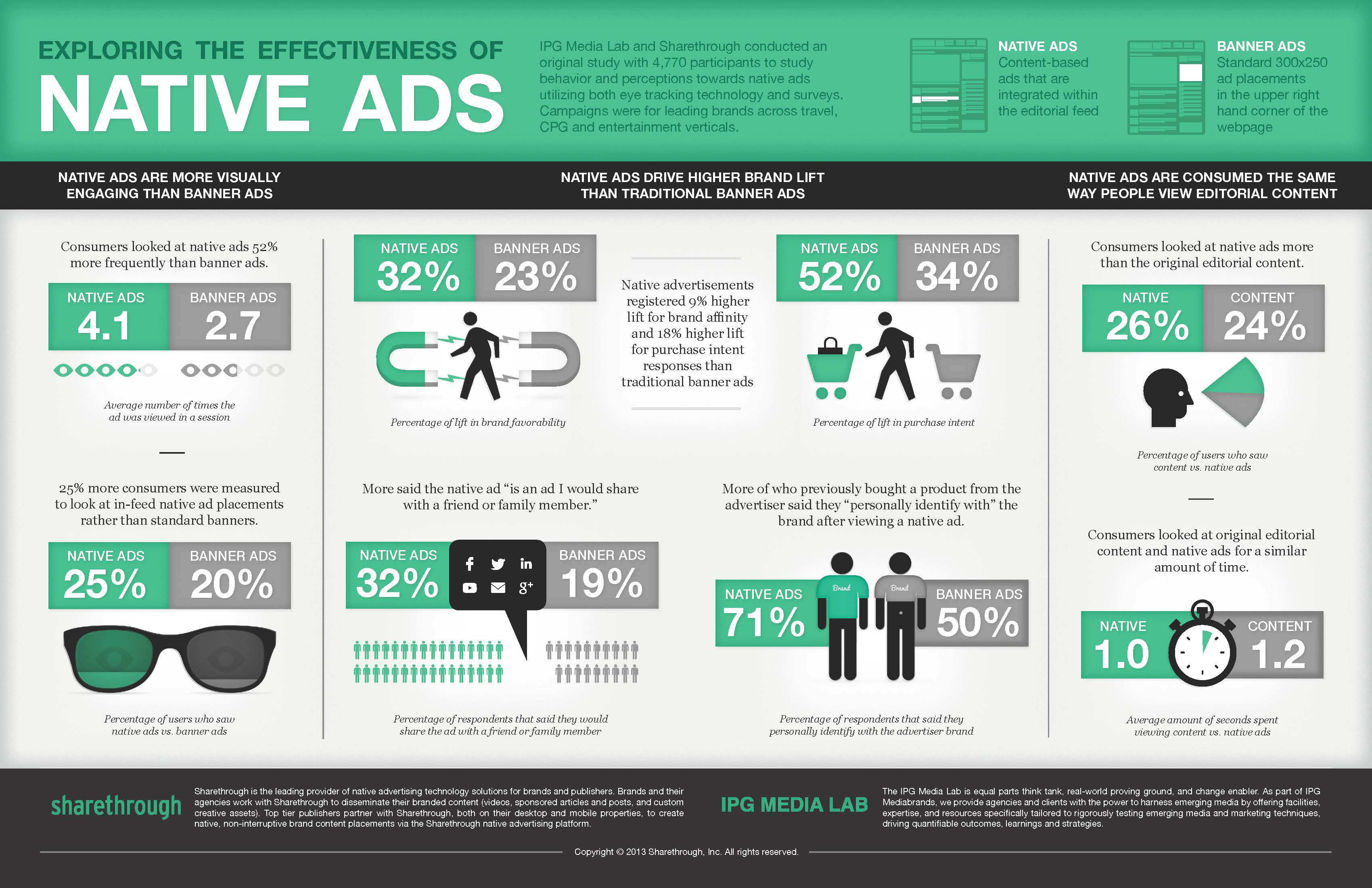
Definitions of native advertising still vary
Native advertising has seen a growing chorus of interest among publishers and ad buyers. Integrating sponsored content into digital channels has opened new doors for marketers to reach distracted consumers and provided publishers with new opportunities to generate ad revenue.
According to a June 2013 survey from the Online Publishers Association (OPA) and Radar Research, while many publishers may still be experimenting with how and what native advertising they will offer, most have already rolled out some native ad opportunities. Nearly three-quarters of polled US publishers said that they already offered native advertising on their site, and another 17% said they were considering offering it this year. Only 10% had no native ad plans of any kind.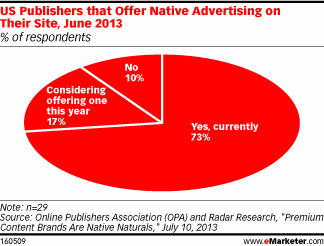
But even as more publishers roll out native advertising, there is still variation in how they think about and begin to define the new ad products. Nearly all publishers attested to the most essential definition of native advertising as “integration into the design of the publisher’s site and [an ad that] lives on the same domain.†And nearly nine out of 10 also said that native advertising was “content produced in conjunction with the advertiser, or by the advertiser, that runs within the editorial stream.†A slightly lesser 79% believed native advertising must be clearly delineated and labeled as such.
These may be crystallizing as the central tenets of native advertising.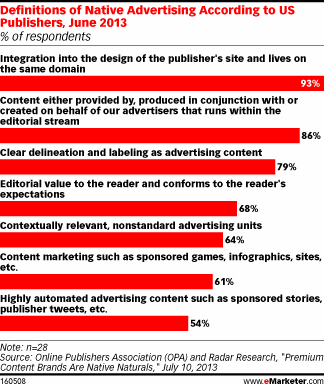
To evaluate their native ad campaigns, publishers said engagement was the leading metric marketers used, cited by 57% of respondents. That was followed by traffic, at 43%. Social sharing came in at one-third of respondents, indicating that while advertisers may want to get consumers sharing their native ad posts, this is not their No. 1 priority.
Market research company BIA/Kelsey estimated in April that this year, US native ad spending on social sites will reach $2.36 billion, or 38.9% of total US paid social ad expenditures. By 2017, social native ad spend will grow to $4.57 billion, and its share of social spending will inch up a few percentage points to 41.7%. But with native advertising reaching into so many digital channels besides social, this is likely far below the total outlays that will go toward native ads in all their different iterations.
eMarketer
DealerNet Services
 Brands, companies, and individuals -- I think it’s time for some real-talk about content and social media. Gary Vaynerchuk recently gave an interview about his decision to employ a full-time stalker (a.k.a “content personâ€) to chronicle, translate, and transcribe his every movement and remark into micro-content for various social media.
Brands, companies, and individuals -- I think it’s time for some real-talk about content and social media. Gary Vaynerchuk recently gave an interview about his decision to employ a full-time stalker (a.k.a “content personâ€) to chronicle, translate, and transcribe his every movement and remark into micro-content for various social media.While I respect Vaynerchuk’s incredible success and agree with his sentiment that micro-content and content in general is incredibly important to the future of business, I question whether encouraging brands and companies to develop this type of content is really what leaders in the social world should be doing.
This massively successful Slideshare presentation speaks to the already overwhelming amount of useless content we experience on a day to day basis. It states that “the single greatest threat to content marketing is content marketing.†The deluge of shoddy, slapped-together content and micro-content that content shops, farms, and agencies are churning out in an attempt to keep up with the growing desire for more and more media is actually what is making us (the collective number of people “listeningâ€) numb to content of quality.
I’m beginning to notice a “content double-take,†where readers are so glazed over scrolling through endless LOLcat updates and tweets about food that they almost (or sadly, sometime do) miss an incredibly important piece of content and have to scroll back to it after the few seconds it takes to sink in.
For instance how many reading actually know what’s happening in Turkey? Or that ExactTarget was acquired by Salesforce for billions of dollars? Or any equally important, business-specific update. I am totally guilty of this “double-take†predisposition and I’ve often missed opportunities to learn, grow as a consumer of content, and be informed about important, bottom-line impacting events. I’ve missed the chance to provide immense value to my community because of precisely the type of content Vaynerchuk is championing.
Do we, the brands and companies with the resources to develop consistent streams of content, want to build a culture of “fast food consumerism†around content and social media? Do we want to actively encourage QWERTY-vomit instead of meaningful, thoughtful insights that could actually benefit another human? Do we want to say without words that “fast and easy†holds more value than “thoughtful and creative?†Should the leading voices in this space really be creating and supporting this type of content?
I don’t think so.
We, as a collective, should be focusing on creating a smarter, more beneficial internet -- for everyone. Web media and the internet’s immense index of knowledge is fundamentally changing the way we learn and communicate across the world. It is the unspoken responsibility of those creating and pushing content (especially from high places) to not muck that up! A recent survey shows that 67.5% of professionals use social media to find and consume content for professional reasons every single day, and this percentage will only grow as more people around the world get connected to social networks.
It is our responsibility to do more, be better, and produce higher-quality resources than we did yesterday. People all over the world are looking to us, as leaders, for inspiration, guidance, and insight -- that they could follow in our footsteps and also be more than the sum of their parts. Failing to recognize this, or recognizing this fact and choosing to ignore it for the “easier†path, is negligent, insular, and selfish.
You may be saying to yourself “well, all that idealistic ‘we can make the world better’ sentiment is nice and all, but I really just care about my bottom line.†I respect your position as a business person but, unfortunately, the point that value and insight should be driving your content development still stands (see above, where 67.5% of professionals use social media to find and consume professional content every day). Diluting the landscape with meaningless drivel produces a more complex, chaotic content landscape that will actually make people pay attention to you less, which, at the end of the day, is the opposite of what we (as brands and business) want.
Let’s be real. More likely than not, if you are reading this, you are not in that top “1-5%,†which means you already have to go above and beyond to be heard through the noise on social media and the web in general. Do you really want to make this more difficult for yourself? Do you want to become a monotonous voice of constant, meaningless communication in a sea of identical monotonous voices or do you really want your message to shine and drive significant impact? Consider this: a recent poll of professionals on the Scoop.it platform presented data that one piece of high-quality content had brought in over $50,000 on average over the lifetime of that content.
A more organized and valuable internet benefits the world, our brands, and our future leaders for the long tail -- not just the short-term vision of the “top 1-5% of executives and social media personalities.†Random updates from the days of these top 1-5% won’t spark creativity or innovation -- the absolutely priceless insight and perspective which the positions of this top 1-5% afford them is what will inspire and help create the leaders of tomorrow. Brands and personalities should be known for who they are, what they stand for, and what they are best at -- not who can create the biggest firehose of social media data.
Who am I to say these things? No one, just a humble content person with a bigger vision for social media and content than tweets with no vowels. Someone who was inspired to do this work because of the incredible insights and sincerity I saw from the brands and online personalities that catapulted social media to its position in the ecosystem of the internet today.
I ask you, brands, companies, and individuals as a peer and fellow creator -- do you want to be remembered because you had amazing, beautiful, insightful things to give to the world or do you want to be remembered because you just wouldn’t shut up? The choice is yours.
ByClair Byrd
DealerNet Services
Your Copywriter Don't Dance and Your Content Don't Rock 'n' Roll [PODCAST] Shake it up Baby!
Tags: If you haven't heard this it's great. If you have it's worth another listen
If you haven't heard this it's great. If you have it's worth another listen
“The Point – In Your Ear†is back sneering at crappy content like the king of rock and roll. In this wild tale, you’ll hear about a street corner advertising rock star, the ho-hum state of online content, the point of view of advertising legend Tom McElligot, how content is too much like merlot, and why you need to step on some blue suede shoes.
It’ll all make sense 9 minutes from now. Enjoy.
Follow this link:Â Podcast
The story begins...
A street corner advertising rock star.
Her job is to generate traffic to the Verizon Wireless store. She has no props. Nor does she hawk an offer you haven't seen a million times. Sounds, pretty ho-hum, I know. But day after day, she's doing her thing on the well-traveled corner of Green Valley and Francisco and she calls a ton of attention to herself and the store. I bet she actually does generate traffic. And I'd bet you an hour wages, she's paid several shillings more than minimum wage. Why?
She dances. Enthusiastically. Oddly, actually. Relentlessly. She has an iPod in her pocket, earbuds in her ears, music in her heart, and she never stops dancing. And believe me, she doesn't dress like or move like a Dallas Cowboys cheerleader. And if you're wondering if she'd cut it on "So You Think You Can Dance," the answer is no chance.
She doesn't bring amazing talent to her extremely unusual profession. She brings originality and passion.
Let's talk about online marketing now.
Listen to the podcast now
http://dealernetservicesonline.biz
Â
CALENDAR
CATEGORIES
TAGS
TWITTER POSTS
CALENDAR
- powered by
- One Big Broadcast
- creative by
- WebStager
© 2025 One Big Broadcast | All rights reserved



